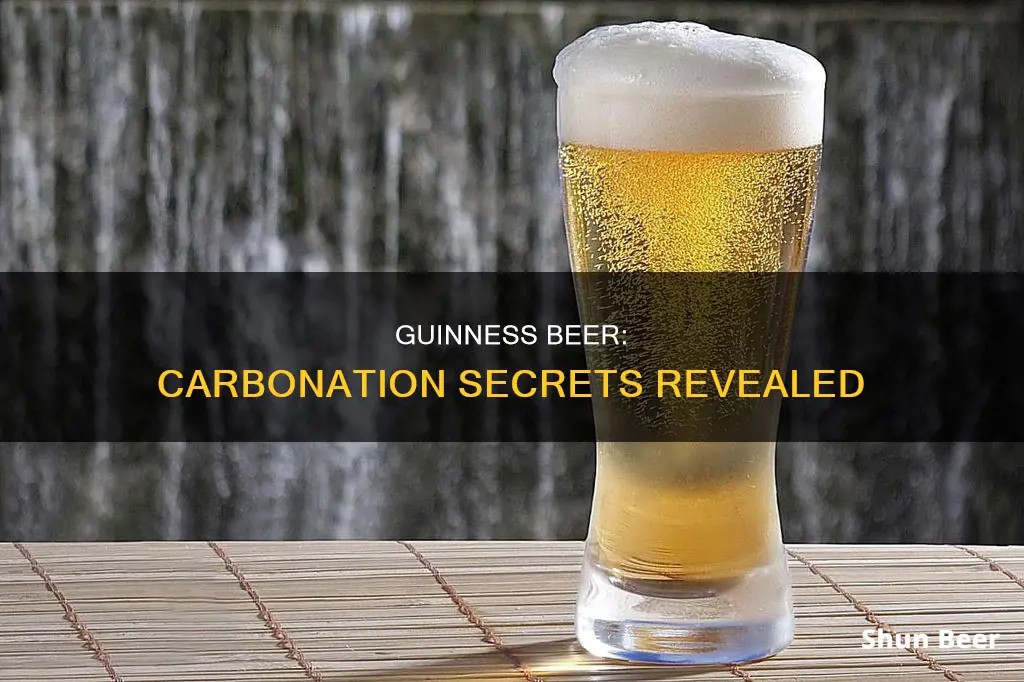
Guinness is a traditional Irish stout beer, first brewed in St. James's Gate, Dublin in the 18th century. It is now available in over 120 countries and is one of the most successful alcohol brands worldwide. Guinness is carbonated, like most beers, but it has a lower level of carbonation than regular lagers. This is because it is carbonated using a mixture of carbon dioxide and nitrogen, which creates smaller bubbles and a creamy mouthfeel, rather than a fizzy one. The creamy head of a pint of Guinness is caused by the nitrogen.
| Characteristics | Values |
|---|---|
| Carbonation | Yes, but less than regular lagers |
| Carbonation type | Natural and forced |
| Carbonation gas | CO2 and nitrogen |
| CO2:nitrogen ratio | 25:75 |
| Bubble size | Small |
| Mouthfeel | Creamy |
What You'll Learn

Guinness is carbonated with a blend of carbon dioxide and nitrogen
Guinness is a traditional Irish stout beer, first brewed in St. James's Gate, Dublin in the 18th century. It is now one of the most successful alcohol brands worldwide, brewed in almost 50 countries and available in over 120.
The distinctive feature of Guinness is its creamy, thick head, which is achieved through a blend of carbonation and nitrogen. While most beers are carbonated with carbon dioxide, Guinness uses a blend of carbon dioxide and nitrogen, with a higher proportion of nitrogen, to create a smoother, creamier texture. This blend is also what gives Guinness its signature cascading pour, as the less soluble nitrogen escapes the liquid rapidly, creating a dramatic visual effect.
The nitrogen and carbon dioxide blend is used in both kegs and cans of Guinness. In kegs, the beer is put under high pressure, allowing it to be forced through small holes in the tap, creating the famous surge. In cans, a widget, a small, nitrogen-filled ball, is used to achieve the same effect when the can is opened. This innovation ensures that drinkers can enjoy a pub-quality pint at home.
The two-part pour, where the glass is first filled three-quarters full and allowed to settle before being topped up, is a well-known ritual associated with Guinness. While some consider it an unnecessary marketing gimmick, it is an integral part of the Guinness experience, adding theatre and ceremony to the drinking process.
Guinness Beer: Does It Expire?
You may want to see also

The nitrogen creates smaller bubbles and a creamy mouthfeel
Nitrogen bubbles are smaller than carbon dioxide bubbles, which gives Guinness its distinctive creamy mouthfeel. The smaller bubbles create a smoother and more delicate texture, akin to a velvety or silky mouthfeel. This is in contrast to the bitter fizz produced by carbon dioxide bubbles in traditional beers. The smaller nitrogen bubbles also provide a more stable beer, as they are less likely to burst when the beer is opened, resulting in a thicker and creamier head.
The addition of nitrogen to beer was first pioneered by Guinness, who developed the "widget" to infuse their canned beers with nitrogen. The widget is a small, hollow, spherical piece of food-grade plastic with a tiny hole in it. During the canning process, brewers add liquid nitrogen to the beer before sealing the can. The liquid nitrogen quickly evaporates, creating pressurised nitrogen gas. This pressurised gas then escapes through the tiny hole in the widget when the can is opened, creating the iconic foamy head of a freshly poured Guinness.
The use of nitrogen in Guinness not only affects the mouthfeel but also subtly alters the aroma and flavour of the beer. The nitrogen bubbles create a "surge and settle" effect, which is now famous in draught Guinness. This two-part pour is essential to achieving the perfect pint of Guinness, with the creamy head and smooth texture that has made it a world-renowned beer.
The nitrogenation process was a significant innovation in the world of brewing, allowing Guinness to transform the fundamental texture and flavour of their beer. The discovery that nitrogen bubbles are much smaller than carbon dioxide bubbles led to a "creamier" and "smoother" consistency, changing the drinking experience and making Guinness one of the most popular stouts worldwide.
Guinness Beer's Ball: A Unique Brewing Mystery
You may want to see also

The two-stage pour is a marketing gimmick
The two-stage pour has persisted as a marketing gimmick, with Guinness even recommending a waiting time of 119.5 seconds between parts. The uniquely annoying wait for the drink to "settle" makes Guinness feel like a special drink and the drinker feel special for enduring it. It speaks to something of the true Gael in us. The two-stage pour also serves as a handy advertising tool for Guinness, as every time a Guinness is poured, it spends a long time sitting on the bar, essentially an advert.
The two-stage pour creates a sense of ritual and anticipation around drinking a pint of Guinness, which has been described as "meditation" or "mindfulness". It adds a dramatic piece of theatre to buying a pint of Guinness and makes the drinker feel like they are taking part in an old Irish tradition. The two-stage pour also gives drinkers something to debate and argue about, with some people insisting that a Guinness poured in one go is inferior, while others claim there is no difference in taste.
While the two-stage pour may have originated as a necessary step in the serving of Guinness, it has evolved into a marketing gimmick that creates a sense of ritual and anticipation around the drink. It is a clever strategy by Guinness to make their product stand out and create a sense of theatre and tradition around the drinking experience.
Guinness Beer: Healthy or Harmful?
You may want to see also

Guinness has less carbonation than regular lagers
Guinness is a traditional Irish stout beer, first brewed in St. James's Gate, Dublin, in the 18th century. It is now sold in over 120 countries and is one of the most successful alcohol brands in the world.
All beer is carbonated, and Guinness is no exception. However, Guinness has less carbonation than regular lagers. This is because it is carbonated using a mixture of carbon dioxide (CO2) and nitrogen, whereas most beers are carbonated using only CO2. Nitrogen bubbles are much smaller than CO2 bubbles, giving Guinness a "creamier" and "smoother" consistency and mouthfeel. This also results in a less acidic taste.
The use of nitrogen in Guinness is due to mathematician-turned-brewer Michael Ash, who in 1959 discovered a way to put the beer under high pressure without making it fizzy. The high pressure of the dissolved gas enables very small bubbles to be formed by forcing the draught beer through fine holes in a plate in the tap. This creates the characteristic "surge" of Guinness, which can also be achieved in cans and bottles through the use of a widget—a small, nitrogen-filled ball.
The "double pour" technique often used when serving Guinness is partly a marketing gimmick, as the beer can easily be poured in one go. However, it creates a memorable drinking experience and adds a dramatic piece of theatre to the act of buying a pint of Guinness.
Guinness Beer: Perfect Pairing Ideas for a Hearty Pint
You may want to see also

The surge and settle effect is caused by nitrogen escaping
The two-stage pour is a direct result of this cascading effect. Guinness doesn't pour as easily as other beers, so it spends a long time sitting on the bar, essentially becoming an advertisement for the brand. The two-stage pour is a marketing strategy that has been so successful that the myth persists that a Guinness poured in one go is inferior. In reality, it is just a handy tool for Guinness's marketing.
The "surge" in the "surge and settle" effect refers to the widget in cans and bottles of Guinness. The widget is a small plastic ball containing nitrogen. After opening the can, the widget drops, and the beer should be poured immediately. The widget functions as an aid to the "surge" part of the process, helping to create the surge and settle effect at home.
The "surge and settle" effect is also achieved on tap by forcing the draught beer through fine holes in a plate in the tap, which causes the characteristic "surge". The perceived smoothness of draught Guinness is due to its low level of carbon dioxide and the creaminess of the head caused by the very fine bubbles that arise from the use of nitrogen and the dispensing method.
The "surge and settle" effect is, therefore, an integral part of the Guinness brand and experience, adding to the theatre and ritual of drinking a pint of Guinness.
Guinness Beer: Iron-Rich Brew or Just a Myth?
You may want to see also







